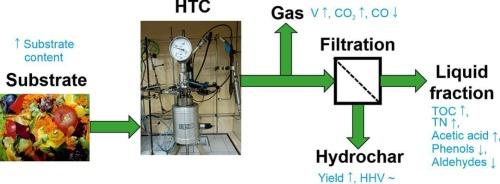初始底物浓度对厨余水热炭化产物的影响。
IF 7.1
2区 环境科学与生态学
Q1 ENGINEERING, ENVIRONMENTAL
引用次数: 0
摘要
本研究的目的是确定餐厨垃圾的初始浓度(KW)对水热碳化(HTC)过程的影响。增加初始KW浓度可使烃类产率从24.5%增加到52.3%,而较高热值(HHV)保持在相似水平(25.7 MJ/kg)。较低的底物浓度导致从烃类中较强的无机化合物浸出。在较低的底物浓度下产生的碳氢化合物在热平衡中燃烧时表现出较高的热稳定性。较高的KW浓度引起液体中碳、氮和乙酸含量的增加。在最高底物浓度下,液相中乙酸、碳和氮的浓度分别为13.1、32.0和1.6 g/L。对液体馏分挥发性有机物的分析表明,增加底物浓度,酚类化合物(从8个减少到3个)和醛类化合物(从3个减少到0个)的数量减少。HTC后产生的液体具有较高的初始KW含量,可以用于沼气生产,因为它含有高负荷的有机碳和很少的抑制微生物的物质。在气相中,较高的初始KW含量增加了CO2的量(从95.1 % vol.增加到98.8% vol.),减少了CO的量(从4.9 % vol.减少到1.2% vol.)。本文章由计算机程序翻译,如有差异,请以英文原文为准。

Influence of the initial substrate concentration on the products obtained during hydrothermal carbonisation of kitchen waste
The aim of this study was to determine the influence of the initial concentration of kitchen waste (KW) on the hydrothermal carbonization (HTC) process. Increasing the initial concentration of KW resulted in an increase in hydrochar yield (from 24.5 to 52.3 % w/w), whereas the higher heating value (HHV) remained at a similar level (25.7 MJ/kg). Lower substrate concentrations led to stronger leaching of inorganic compounds from the hydrochar. Hydrochar produced at lower substrate concentrations exhibits higher thermal stability during combustion in a thermobalance. Higher KW concentrations caused an increase in the carbon, nitrogen and acetic acid content in the liquid. At the highest substrate concentration, the concentrations of acetic acid, carbon and nitrogen in the liquid phase were equal to 13.1, 32.0 and 1.6 g/L, respectively. Analysis of volatile organic compounds in the liquid fraction revealed that increasing the substrate concentration decreased the number of phenolic compounds (from 8 to 3) and aldehydes (from 3 to 0). The liquid produced after HTC with a high initial KW content can be used for biogas production because it contains a high load of organic carbon and few substances that inhibit microorganisms. In the gas phase, a higher initial KW content increased the amount of CO2 (from 95.1 to 98.8 % vol.) and a decreased the amount of CO produced (from 4.9 to 1.2 % vol.).
求助全文
通过发布文献求助,成功后即可免费获取论文全文。
去求助
来源期刊

Waste management
环境科学-工程:环境
CiteScore
15.60
自引率
6.20%
发文量
492
审稿时长
39 days
期刊介绍:
Waste Management is devoted to the presentation and discussion of information on solid wastes,it covers the entire lifecycle of solid. wastes.
Scope:
Addresses solid wastes in both industrialized and economically developing countries
Covers various types of solid wastes, including:
Municipal (e.g., residential, institutional, commercial, light industrial)
Agricultural
Special (e.g., C and D, healthcare, household hazardous wastes, sewage sludge)
 求助内容:
求助内容: 应助结果提醒方式:
应助结果提醒方式:


